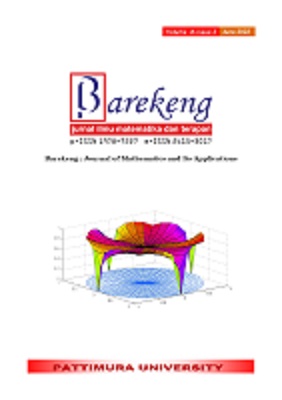ON THE BEHAVIOR ANALYSIS OF SUSCEPTIBLE, INFECTION, RECOVERY (SIR) MEASLES SPREAD MODEL WITH AGE STRUCTURE
Abstract
This study discusses the behavior analysis model of the Susceptible-Infected-Recovered (SIR) epidemic of the spread of measles based on age structure. The total population is grouped into four age groups, the first age group (0-4 years), the second age group (5-9 years), the third age group (10-14 years), and the fourth age group (> 15 years). The steps in analyzing the behavior of the model can be done by determining the equilibrium point, basic reproduction number, and stability analysis at the equilibrium point. In the measles distribution model with four age groups, where each age group has no interaction with other age groups, sixteen equilibrium points are obtained, which are a combination of the disease-free equilibrium and endemic equilibrium points separately. The stability properties of each equilibrium point can be determined by the value of the basic reproduction number (R_0) which is the product of the basic reproduction number of each age group. The measles disease-free equilibrium point will be locally asymptotically stable when R_0<1, meanwhile the endemic equilibrium point is locally asymptotically stable when R_0>1. This research contributes to providing information to both the government and the public.
Downloads
References
Maldonando, "Principles and Practice of Pediatic Infectious Diseases," Rubeola Virus (Measles and Subacute Sclerosing Panencephalitis), pp. 1137-1144, 2011.
WHO, "Treating Measles in Children," World Health Organization, 2004. [Online]. Available: www.who.int/immunization.
Nurani, "Gambaran Epidemiologi Kasus Campak di Kota Cirebon 2004-2011," Jurnal Kesehatan Masyarakat, pp. 862-874, 2012.
Direktorat Jenderal Pencegahan dan Pengendalian Penyakit Indonesia, "Petunjuk Teknis Kampanye Imunisasi Measles-Rubella," 2017. [Online]. Available: http://www.depkes.go.id. [Accessed Januari 2018].
Fitria, "Model Matematika Penyebaran Penyakit Tuberkolosisi di Rumah Sakit Paru-Paru Batu," Jurnal JITIKA, vol. 5, pp. 60-62, 2011.
C. M. &. W. D. Zill, Differential Equations with Boundary Value Problems (8 ed), New York: Cengage Learning, 2013.
Waluya, Persamaan Differensial, Yogyakarta: Graha Ilmu, 2006.
Nababan, S.M, Persamaan Differensial Biasa, Jakarta: Universitas Terbuka, 2014.
A. N. Azizah, "Model SIR Pada Epidemi Penyakit Campak Berdasarkan Umur Dengan Pengaruh Imunisasi," Jurnal Ilmiah Matematika, vol. 3, no. 6, 2017.
Mutmainah, "Model Dinamika Penyebaran Penyakit Campak Dengan Pengaruh Vaksinasi dan Penerapannya di Provinsi Nusa Tenggara Barat," Jurnal Matematika, vol. 8, no. 2, pp. 112-121, 2019.
Y. W. Y. X. ,. M. Y. Linhua Zhou, "Global Dynamics of a Discrete Age-Structured SIR Epidemic Model with Applications to Measles Vaccination Strategies," Journal Mathematics Bioscience, vol. 308, pp. 385-395, 2019.
J. Chin, Manual Pemberantasan Penyakitt Menular Edisi 17, Jakarta: Bakti Husada, 2000.
Raid Kamel Naji, Reem Mudar Hussien, "The Dynamics of Epidemic Model with Two Types of Infectious Diseases and Vertical Transmission", Journal of Applied Mathematics, vol. 2016, Article ID 4907964, 16 pages, 2016. https://doi.org/10.1155/2016/4907964.
D. &. Heesterbeek, Mathematical Epidemiology of Infectious Diseases: Model Building, Analysis and Interpretation, United State of America: John Wiley & Sons, Inc, 2000.
Ningsih, Y. L, Mulbasari, A. S, “Exploring Students’ Difficulties in Solving Nonhomogeneous 2nd Order Ordinary Differential Equations with Initial Value Problems”, Al-Jabar: Jurnal Pendidikan Matematika, vol. 10, no. 2, pp. 233-242, 2019.
Authors who publish with this Journal agree to the following terms:
- Author retain copyright and grant the journal right of first publication with the work simultaneously licensed under a creative commons attribution license that allow others to share the work within an acknowledgement of the work’s authorship and initial publication of this journal.
- Authors are able to enter into separate, additional contractual arrangement for the non-exclusive distribution of the journal’s published version of the work (e.g. acknowledgement of its initial publication in this journal).
- Authors are permitted and encouraged to post their work online (e.g. in institutional repositories or on their websites) prior to and during the submission process, as it can lead to productive exchanges, as well as earlier and greater citation of published works.






1.gif)



